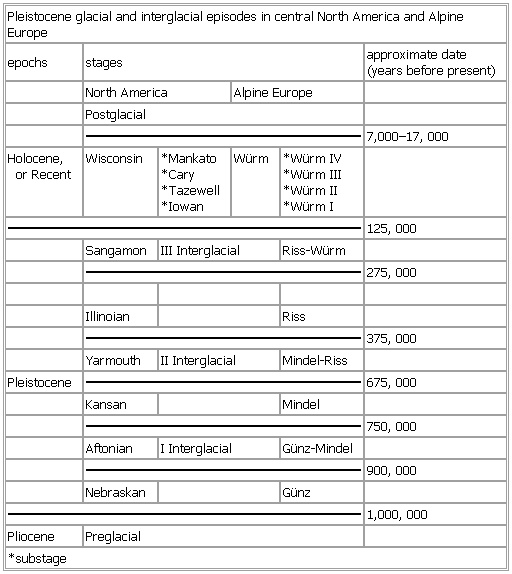Pleistocene glacial and interglacial episodes in central North America and Alpine Europe
- Pleistocene glacial and interglacial episodes in central North America and Alpine Europe
-
Pleistocene glacial and interglacial episodes in central North America and Alpine Europe
epochs stages approximate date
(years before present)
North America Alpine Europe
Postglacial
7,000–17,000
Holocene,
or Recent Wisconsin *Mankato
*Cary
*Tazewell
*Iowan Würm *Würm IV
*Würm III
*Würm II
*Würm I
125,000
Sangamon III Interglacial Riss-Würm
275,000
Illinoian Riss
375,000
Yarmouth II Interglacial Mindel-Riss
Pleistocene
675,000
Kansan Mindel
750,000
Aftonian I Interglacial Günz-Mindel
900,000
Nebraskan Günz
1,000,000
Pliocene Preglacial
*substage
See as table:
* * *
Universalium.
2010.
Look at other dictionaries:
North America — North American. the northern continent of the Western Hemisphere, extending from Central America to the Arctic Ocean. Highest point, Mt. McKinley, 20,300 ft. (6187 m); lowest, Death Valley, 276 ft. (84 m) below sea level. 400,000,000 including… … Universalium
glacial stage — ▪ geologic time in geology, a cold episode during an ice age, or glacial period. An ice age (q.v.) is a portion of geologic time during which a much larger part of the Earth s surface was covered by glaciers than at present. The Pleistocene … Universalium
climate change — Introduction periodic modification of Earth s climate brought about as a result of changes in the atmosphere as well as interactions between the atmosphere and various other geologic, chemical, biological, and geographic factors within the Earth … Universalium
quaternary — /kwot euhr ner ee, kweuh terr neuh ree/, adj., n., pl. quaternaries. adj. 1. consisting of four. 2. arranged in fours. 3. (cap.) Geol. noting or pertaining to the present period of earth history, forming the latter part of the Cenozoic Era,… … Universalium
Paleolithic — The Paleolithic This box: view · talk · edit ↑ before Homo (Plioc … Wikipedia
Australia — /aw strayl yeuh/, n. 1. a continent SE of Asia, between the Indian and the Pacific oceans. 18,438,824; 2,948,366 sq. mi. (7,636,270 sq. km). 2. Commonwealth of, a member of the Commonwealth of Nations, consisting of the federated states and… … Universalium
Asia — /ay zheuh, ay sheuh/, n. a continent bounded by Europe and the Arctic, Pacific, and Indian oceans. 2,896,700,000; ab. 16,000,000 sq. mi. (41,440,000 sq. km). * * * I Largest continent on Earth. It is bounded by the Arctic Ocean, the Pacific Ocean … Universalium
Geologic time scale — This clock representation shows some of the major units of geological time and definitive events of Earth history. The Hadean eon represents the time before fossil record of life on Earth; its upper boundary is now regarded as 4.0 Ga.[1] Other… … Wikipedia
Little Ice Age — The reconstructed depth of the Little Ice Age varies between different studies (anomalies shown are from the 1950–80 reference period). The Little Ice Age (LIA) was a period of cooling that occurred after the Medieval Warm Period (Medieval… … Wikipedia
Silurian Period — Interval of geologic time, 443–417 million years ago. The third period of the Paleozoic Era, the Silurian follows the Ordovician Period and precedes the Devonian. It marks the first appearance of land plants and jawed fishes. The continents were… … Universalium

